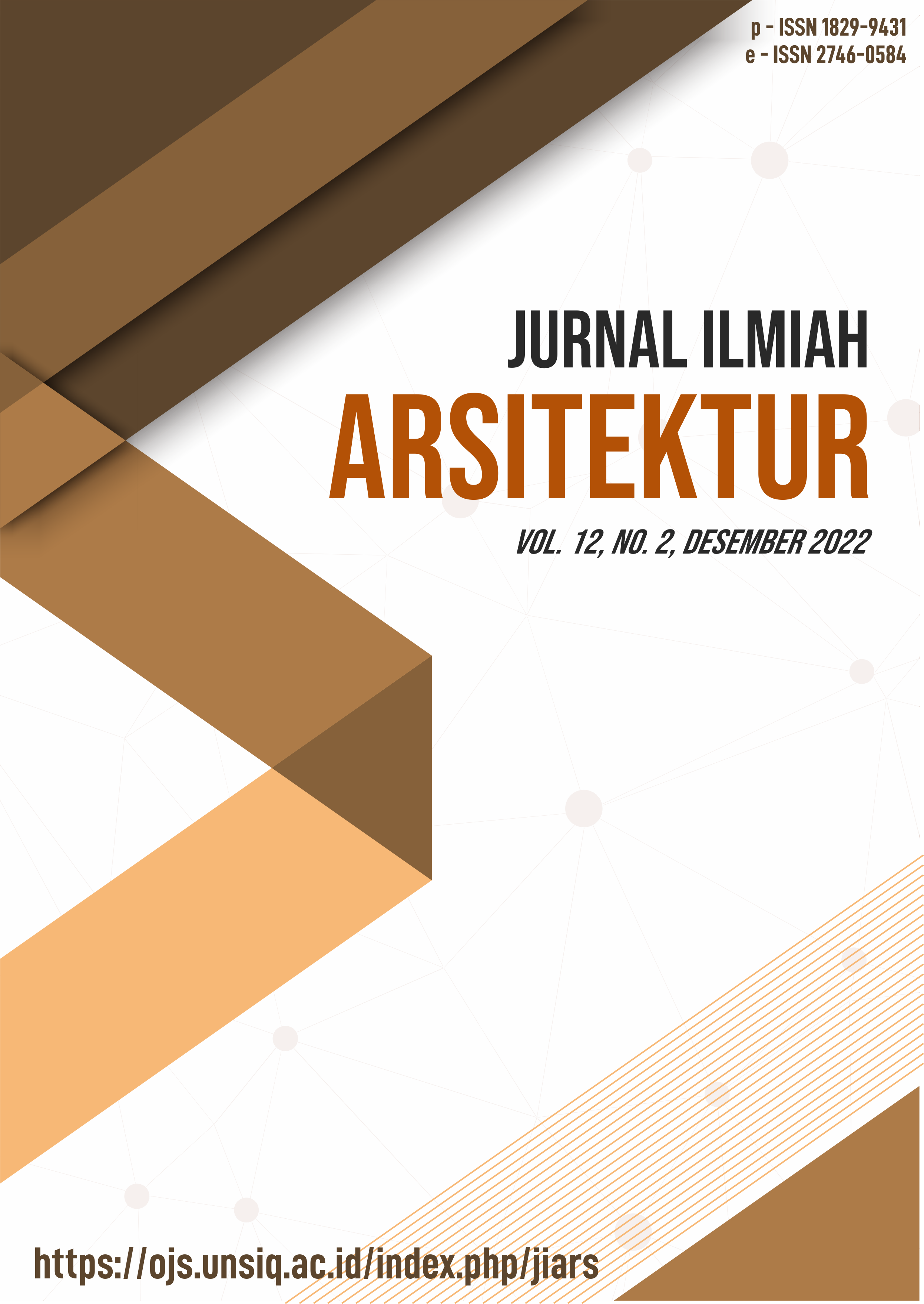TERITORI RUANG KOMUNAL BERBASIS WAKAF DI PERMUKIMAN KOTA (STUDI KASUS KAMPUNG KAUMAN SEMARANG)
DOI:
https://doi.org/10.32699/jiars.v12i2.3558Keywords:
Territory, Communal space, Land waqf, Urban settlement, Kauman VillageAbstract
Urban regions nowadays are constrained by a scarcity of land for the construction of community space. The waqf of land is one of the charitable endeavours that has been long-established in the neighbourhood. Because the waqf serves as the primary gathering place for the community that manages it, the Muslim community's act of prayer directly influences the spatial organisation of the city. Waqf is practised by almost all Muslim communities worldwide. Waqf has a significant role in defining the city's community spaces, including as places of worship, places of learning, places of health, economies, businesses, and environmental infrastructure. Seventy percent of urban villages, like Semarang City, hold waqf land. The goal of this study is to provide a description of the area of community space that develops from land waqf in urban communities. Kampung Kauman Semarang was chosen for the study because it is a crowded community representative of urban centres. To comprehend territorial traits that are specifically generated in the midst of people's lives, the research technique employs a holistic single case study methodology. This research contributes to our understanding of how waqf territoriality develops through communal defence and the long-term creation of benefits in a variety of dimensions, reflecting the qualities of sustainable space.
Keywords: Territory, Communal space, Land waqf, Urban settlement, Kauman Village
References
Al Batul, U., Indrosaptono, D., & Sardjono, A. B. (2022). Kajian Faktor Perilaku Pemanfaatan Teritori Publik Oleh Pedagang Di Pasar Jatingaleh Semarang. Jurnal Arsitektur ARCADE, 6(2), 161. https://doi.org/10.31848/arcade.v6i2.998
Ali, M. A. (2020). Takmir masjid harus tahu, perbedaan wakaf dan hibah (Hadiah). https://www.youtube.com/watch?v=ZDy8TuejPE0
Amedeo Giorgi. (2009). The descriptive phenomenological method in phychology: A modified husserlian approach. Duquesne University Press.
Creswell, J. W. (2019). Research Design, Pendekatan Metode Kualitatif, Kuantitatif, dan Campuran (Cetakan IV). Pustaka Pelajar.
Djalaluddin, A. (2020). Sistem Waqaf : Inspirasi Membangun Peradaban Kesehatan Pasca Covid-19.
Jon Lang. (1987). Creating Architectural Theory. Van Nostrand Reinhold Company.
Khan, I., Lewis, M., & Cañamero, L. (2019). The Effects of Affective Social Bonds on the Interactions and Survival of Simulated Agents. 2019 8th International Conference on Affective Computing and Intelligent Interaction Workshops and Demos (ACIIW), 374–380. https://doi.org/10.1109/ACIIW.2019.8925031
Kusumastuti, K., Miladan, N., Istanabi, T., Suminar, L., Yudana, G., Aliyah, I., Soedwiwahjono, S., Pamardhi-Utomo, R., Werdiningtyas, R., & Putra, R. P. (2021). Peran Kelompok Swadaya Masyarakat Dalam Mewujudkan Penataan Kampung Yang Berkelanjutan (Studi Kasus : Kampung Ngemplak, Jebres, Kota Surakarta). Desa-Kota, 3(2), 171. https://doi.org/10.20961/desa-kota.v3i2.45466.171-178
Manurung, P., & Ikaputra, I. (2020). Mekanisme Mempertahankan Teritori dalam Lingkungan Binaan. Tataloka, 22(4), 623–642. https://doi.org/10.14710/tataloka.22.4.623-642
Putra G, A., & Zahro H, Z. (2019). Desain Partisipasi Dalam ruang Publik, Ruang komunal Sosial Dalam Kampung Heritage TawangsariSebagai Salah Satu Bentuk Aplikasi Unsur Keberlanjutan Sosial. PAWON: Jurnal Arsitektur, III, 25–36.
Sara, R., Jones, M., & Rice, L. (2021). Austerity urbanism: connecting strategies and tactics for participatory placemaking. CoDesign, 17(4), 493–509. https://doi.org/10.1080/15710882.2020.1761985
Sastrosasmito, S. (2020). Arsitektur sebagai realitas kemanusiaan (Dari keseharian sampai kesadaran transendental). ARTEKS : Jurnal Teknik Arsitektur, 5(2), 141–142. https://doi.org/10.30822/arteks.v5i2.531
Sejarah Singkat Yayasan Badan Wakaf Sultan Agung. (2022). https://ybw-sa.org/sejarah-singkat/
Setiawati, N. A. (2018). Manajemen Sejarah Berbasis Komunitas: Pengembangan Kawasan Kauman sebagai Living Museum. Bakti Budaya, 1(1), 101. https://doi.org/10.22146/bb.37934
Singer, A. (2018). Replace stasis with motion to fathom the persistence of Waqf: The complex histories and legacies of a Muslim institution. Muslim World, 108(4), 702–716. https://doi.org/10.1111/muwo.12270
siwag.kemenag.go.id. (2021).
Suprapti, A., Kistanto, N. H., Pandelaki, E. E., & Indrosaptono, D. (2017). Control of spatial protection in Kauman Semarang. Journal of Architecture and Urbanism, 41(4), 268–277. https://doi.org/10.3846/20297955.2017.1402717
Tamariska, S. R., Ronauly, A. A., Nugraha, M. S., Nurhasan, T., & Fillah, A. Z. (2020). Studi Komparasi Perumahan Terencana Dan Perumahan Tidak Terencana (Perumahan Sukaluyu Dan Kampung Tubagus Ismail Bawah ). 285–292.
Yunita, I. M., & Wijaya, I. N. S. S. (2021). Tingkat keberlanjutan permukiman kampung warna-warni, kelurahan jodipan, kota malang. Planning for Urban Region and Environment, 10(1), 145–156.














